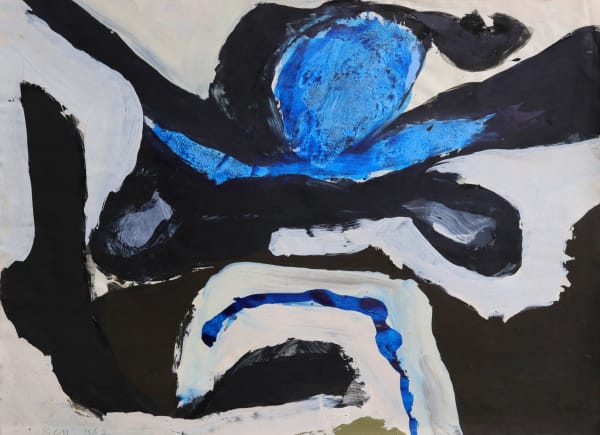Trevor Bell British, 1930-2017
“The vibrant abstract paintings and drawings of Trevor Bell, helped define the modern art of the community of St Ives”. Trevor Bell’s Obituary in the Guardian, 10 Nov 2017.
Trevor Bell was born in Leeds in 1930 to Harold Bell, a sales representative for a chemicals firm, and Elizabeth, a teacher. Both parents encouraged their son’s evident artistic talent. On leaving Roundhay school in Armley he gained a scholarship to attend the Leeds College of Art between 1947 and 1952. There he met Dee Hobdell, whom he married after graduating. He took a teacher training course and, returning to Yorkshire after a short period in London, had various part-time jobs teaching art in evening and Saturday classes.
In 1955, encouraged by Terry Frost who was then at Leeds University, Bell moved to Cornwall at a time when St Ives was the UK’s centre of abstract art. Bell soon met the leading figures of the town’s burgeoning artistic community; Patrick Heron, Peter Lanyon, Ben Nicholson, Naum Gabo and Barbara Hepworth. The young artist shared a studio with the British/ American sculptor Brian Wall in the basement of the St Ives seamen’s mission. In St Ives Bell quickly found recognition. Nicholson, along with his dealer Charles Gimpel, encouraged Bell to show in London and Waddiington Galleries gave the aspiring artist his first solo exhibition in 1958. Patrick Heron wrote the introduction to the exhibition catalogue, stating that Bell was “the best non-figurative painter under thirty”. In 1960 he returned to Leeds as a the youngest ever Gregory fellow at Leeds University, whose advisors at the time were Sir Herbert Read and Henry Moore. The move afforded Bell two years of unencumbered work and affirmed his artistic lineage. It was also during this period that Bell began to use flat surfaces and brilliant colour, combining these with angular canvases that set his work apart from other artists of his generation.
In 1959 Bell was awarded the Paris Biennale International Painting Prize, and an Italian Government Scholarship.
Throughout the 1960s Bell showed work in exhibitions in the UK and USA including a major touring exhibition covering the period of 1966 to 1970, organised by the Richard Demarco Gallery in Edinburgh. During this time his work was bought for the Tate collection including Overcast (1961) purchased from the Waddington Galleries in 1962 under the Knapping Fund.
Bell spent a significant part of his career in the US, where he is remembered as a charismatic teacher, as well as for huge, expansive paintings and public artworks. He witnessed first-hand the night-time launch of the Apollo 17 space mission at Cape Canaveral. As the Guardian observed in Bell's Obituary in 2017, “The heroic modernity of the space race, the awe felt at the spectacle of fire and light, seemed a metaphor for Bell’s belief in the energy and optimism of modern painting, as well as being a source for a new brilliance of colour and elongated angular canvas forms”. By now Bell’s paintings were huge and in 1973 he presented his recent works in a solo exhibition at the Whitechapel Gallery in London, having just taken part in a major exhibition at the Corcoran Gallery in Washington, D.C.
Over the course of the next thirty years Bell combined painting with teaching moving to Florida State University, Florida in 1976 to become the Professor for Master Painting. The campus at Tallahassee was no St Ives, but Bell could work there with freedom and support, and became quite dedicated to the university and his position. He designed a huge warehouse-style studio with mobile screens to house multiple paintings in progress. Here he was able to produce the large-scale, intensely coloured works for which he is best known, expressing the influence of the climate and landscape upon the artist and his work. He was resident for the next 20 years in America but also travelled frequently; the Zanskar river valley in the Ladakh region of India, with its Buddhist monasteries and shrines, becoming a special place for him.
Further important exhibitions were held at the Corcoran Gallery and the Academy of Sciences in Washington, the Metropolitan Museum in Miami, The Cummer Gallery and the Museum of Art at Fort Lauderdale, Florida. In 1985 Bell was included in the London Tate Gallery's St Ives 1939-64 exhibition and in 1993 he was part of the inaugural show of the Tate St Ives, where he was again re-established as part of the St Ives artists and benefited from the consequent renewal of interest in British modernist art.
In 1996, upon retiring from Florida State University, Bell returned to Cornwall, restoring an isolated farmhouse and barns on the Penwith moors. Its rooms were painted in his characteristic brilliant palette and he continued to exhibit in London, the USA and St. Ives.
That same year he was invited to have a solo exhibition in the Tate St Ives, which culminated in a long-term relationship with the gallery.
In 2007 Tate St Ives was again filled with Bell’s works selected from five decades of his career. Quiet light-filled canvases were displayed against other much darker, strident works expressing over-powering Cornish gales. The exhibition brought into sharp focus Bell’s restless energy and provided a sense of the very considerable achievement of making such vast and complex canvases. In 2011, a further 14 works were obtained by the Tate Gallery for their permanent collection.
In the final months of his life Trevor Bell was still in the studio, and still planning new projects. After a short illness, Trevor Bell died on 3 November 2017, at the age of 87.


